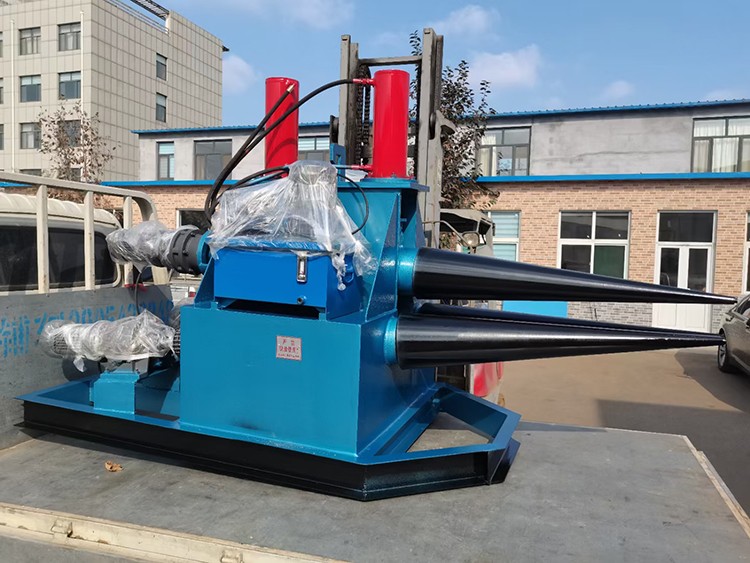

Earning the trust of countless customers, with over a decade of meticulous craftsmanship in the field of cone rolling machine manufacturing, we will now detail how to prevent deformation and wrinkles in thin plate cone rolling:

In the field of metal sheet processing, the cone rolling process imposes stringent requirements on thin sheet processing. Due to the low rigidity of thin sheet materials, deformation and wrinkling issues often arise during the rolling of conical components, which can adversely affect product quality. To address these issues, targeted measures must be implemented across three key areas: material properties, equipment adjustment, and process control.
1, Understanding material properties
The physical properties of thin sheet metal directly affect the rolling results. Before processing, it is necessary to confirm the material, thickness, and mechanical properties of the sheet metal. Different types of metal sheets have different ductility and elasticity properties. For example, stainless steel is more prone to work hardening than ordinary carbon steel. The thickness tolerance of the sheet metal must be controlled within the allowable range, as uneven thickness will cause uneven stress during rolling.
Material pretreatment is an important step. For sheets with scratches or uneven surfaces, flattening treatment is required first. Certain special materials need to undergo annealing treatment before rolling to eliminate internal stress. The cut edges of the sheets should be kept flat, and burrs must be completely removed, otherwise they will become the starting point for wrinkles.
2, Key points for equipment adjustment
The mechanical condition of the roll forming machine directly affects the processing quality. The parallelism of the upper and lower rolls needs to be checked regularly, as excessive deviation will cause the sheet metal to skew. The surface of the roll shaft must be kept clean and free of dents or rust. If necessary, special polishing tools can be used for treatment. For sheet metal of different thicknesses, the roll shaft gap must be adjusted accordingly, as excessive gaps will reduce forming accuracy.
The choice of mold is equally critical. When rolling conical parts, molds with specific curvatures must be used. The radius of the mold's arc must match the target taper. A radius that is too small will increase material flow resistance, while a radius that is too large will reduce forming efficiency. The mold must be securely installed; any looseness will result in uneven pressure during the rolling process.
3, Process control methods
The feeding method is important for preventing wrinkles. The sheet metal should be fed into the rollers smoothly, preferably using an auxiliary feeding device. The feeding angle should be consistent with the tangential direction of the mold; angle deviations can cause material accumulation. For longer sheets, intermediate supports should be added to prevent sagging and deformation due to self-weight.
Parameter control during the rolling process is particularly critical. Downward pressure must be applied in stages and should not be applied all at once. After rolling a certain angle, the process should be paused to check the forming status and adjust parameters in a timely manner. The rotational speed must be controlled appropriately; too fast will cause uncontrolled material flow, while too slow will increase the risk of stress concentration. For materials that are prone to springback, over-rolling can be performed appropriately to allow for springback.
Post-processing is equally important. After rolling is complete, do not remove the workpiece immediately; instead, maintain a certain amount of forming pressure for a specified period of time. For products with high precision requirements, secondary calibration can be performed. When welding joints, control heat input and use segmented welding to minimize thermal deformation. When storing finished products, use specialized racks to prevent deformation caused by stacking.
The experience of operators is crucial. Through practical experience, they should master the deformation patterns of different materials and establish a parameter database. After each processing operation, process parameters and product quality should be recorded to form traceable technical records. Regular maintenance and servicing of equipment should be conducted to ensure that mechanical precision remains in good condition. With technological advancements, some new auxiliary processes such as laser-assisted forming are also worth exploring and applying.
If you are interested in plate rolling machines, please contact us.
 Address:Room 1202, Detaitang Building, No. 118 Huaguang Road, Zhangdian District, Zibo, Shandong
Address:Room 1202, Detaitang Building, No. 118 Huaguang Road, Zhangdian District, Zibo, Shandong WhatsApp:+8615653328535
WhatsApp:+8615653328535 Wechat: +8615965331535
Wechat: +8615965331535  E-mail:zs@sdsmachinery.com
E-mail:zs@sdsmachinery.com